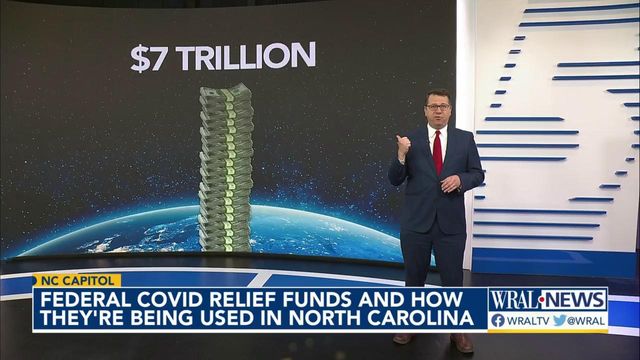Billions in federal COVID money came North Carolina's way. Where's it going now?
The state is tracking roughly $81 billion in federal pandemic stimulus spending - so much that it started a new office last year to keep up with everything.
Posted — UpdatedLots of this federal money was spent last year, on stimulus checks that went direct to families, forgivable loans to keep businesses afloat, virus testing, vaccine research and a $10 billion boost to unemployment checks that, at one time or another, went out to nearly a million people.
But there are billions left, and that money will be spent over a span of years. Among other things, the state has already spent or expects to spend:
- $8.3 billion on education, including K-12, universities and community colleges. Much of this doesn't have to be spent until 2024 because it just passed Congress in March.
- $1.1 billion for coronavirus testing, tracing and prevention
- $2.3 billion that got kicked down to North Carolina hospitals to cover health care expenses and lost revenue from procedures canceled due to COVID-19
- $358 million for North Carolina airports that were nearly deserted for much of the pandemic.
- $1.2 billion for rental assistance in North Carolina as an ongoing program gets refills from the federal government and is still accepting applications
- $273 million to help people struggling to pay their mortgages. That program isn't up and running yet, but there will be income limits.
Congress sent this money down through three major bills – the CARES Act in March 2020, the Consolidated Appropriations Act in December and the American Rescue Plan, which passed about three months ago.
Altogether, the measures totaled some $6.1 trillion.
Even that doesn’t cover it all. The federal reserve cut interest rates, making it cheaper for banks to borrow money. It also bought securities, and altogether essentially spewed money into the economy, adding as much as another $6 trillion to the recovery when everything’s said and done, according to the money tracker.
“This has been the most interventionist the federal government has ever been," North Carolina State University economist Mike Walden said in a recent interview.
State, local governments get money
Most of that money flows through state government, though three rounds of stimulus payments went directly to people, and local governments are handling some of the spending as well.
All 100 North Carolina counties get money direct from the federal government, as do cities with populations above 50,000. Smaller municipalities could apply for funding, and the deadline was Friday. The Pandemic Recovery Office said 485 out of the 525 eligible had applied as of last Tuesday.
The state and these local governments have five years to spend the money. The state used some of it already to cover regular salary costs for employees, many of whom had to work overtime during the pandemic to make up for staffing shortages caused by the virus.
The state Department of Public Safety, which houses the prisons system as well as the State Highway Patrol, used $672 million in federal funding to pay front-line law enforcement, including correctional officers.
Too much money?
All of this money queued up, combined with other economic realities around the world, may drive up prices for goods and services.
"Inflation is here," North Carolina State Treasurer Dale Folwell said earlier this month. "It's not coming; it's here."
World supply chains, crippled during the pandemic, are struggling to ramp back up and hire enough workers to meet demand. Add it all together and you "run into a situation of too many dollars chasing too few goods and services," Walden wrote in a recent column.
If other states do so as well, that will drive up the cost of the equipment needed to make those projects a reality.
Folwell said this month that, "North Carolina is drowning in money."
Marcia Evans, spokeswoman for the Pandemic Recovery Office, said the state "can identify more than enough needs for state and federal resources combined."
"Everything from water and sewer to child care – this is a transformational amount of funding, but it’s still short of projected need," Evans said in an email. "The demand for services will continue even as COVID-19 infection rates are declining. The efficiency of spending assistance funds should be viewed over the longer period of recovery, not as a single budget cycle."
Spending on generational projects
Building out broadband in the state could change communities for decades to come, making rural areas more hospitable for business, for example.
Lawmakers may also dedicate federal dollars to water and sewer projects, addressing long-term needs in communities with aging systems and, in many cases, a diminishing customer base.
Among other things, the governor wants to provide at least $6,000 a year to students from families that make $60,000 a year or less in salary to cover tuition, fees and other costs of attending a public North Carolina university or community college.
Lee Lilley, the Cooper administration's director of pandemic recovery, said the money available, and the time state and local governments have to spend it, may lead to a number of large, collaborative projects.
"In addition to the huge potential of the projects alone, the massive infusion of cash at the state and local level can be transformational for small and minority-led contractors, many of whom have been historically left out," Lilley said via email. "We can create value from these funds in more ways than one with benefits across our economy and communities."
Related Topics
• Credits
Copyright 2024 by Capitol Broadcasting Company. All rights reserved. This material may not be published, broadcast, rewritten or redistributed.






